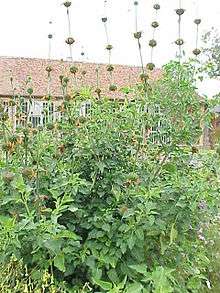Leonotis nepetifolia
Leonotis nepetifolia, (also known as klip dagga, Christmas candlestick, or lion's ear[1]), is a species of plant in the genus Leonotis and the family Lamiaceae (mint). It is native to tropical Africa and southern India. It can also be found growing abundantly in much of Latin America and the West Indies.[2] It grows to a height of 3 metres (9 ft 10 in) and has whorls of striking lipped flowers, that are most commonly orange,[1] but can vary to red, white, and purple. It has drooping dark green, very soft serrated leaves that can grow up to 10 centimetres (4 in) wide.[1] Sunbirds and ants are attracted to the flowers.[1] It has been found growing on road sides, rubbish heaps or waste land.[1]
- Varieties
- Leonotis nepetifolia var. africana (P.Beauv.) J.K.Morton - Indian Subcontinent, much of Africa
- Leonotis nepetifolia var. nepetifolia - much of Africa
| Leonotis nepetifolia | |
|---|---|
 | |
| Scientific classification | |
| Kingdom: | Plantae |
| Clade: | Tracheophytes |
| Clade: | Angiosperms |
| Clade: | Eudicots |
| Clade: | Asterids |
| Order: | Lamiales |
| Family: | Lamiaceae |
| Genus: | Leonotis |
| Species: | L. nepetifolia |
| Binomial name | |
| Leonotis nepetifolia | |
Related species
Leonotis nepetifolia (klip dagga) is related to L. leonurus (wild dagga or lion's tail.) The most noticeable difference between the two is the leaf shape. L. nepetifolia leaves are cordate with serrated edges, except the top pair which are lanceolate with serrated edges, as pictured in taxonomy box. The leaves are all lanceolate with serrated edges on L. leonurus.
Traditional medicine
Leonotis nepetifolia is known in Trinidad as shandilay and the leaves are brewed as a tea for fever, coughs, womb prolapse and malaria.[3]
Gallery
- Leaf
_in_Narshapur%2C_AP_W_IMG_1164.jpg) Flowers
Flowers
References
- Napier, E. "NOTES· ON WILD FLOWERS" (PDF). biodiversitylibrary.org. Retrieved 31 December 2017.
- Kew World Checklist of Selected Plant Families
- Mendes, John. 1986. Cote ce Cote la: Trinidad & Tobago Dictionary, Arima, Trinidad, p. 135.
External links
- FloraBase - Information on L. nepetifolia in Western Australia
- Information on cultivating ethnoplants cultivating L.nepetifolia (French)